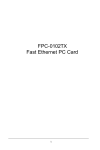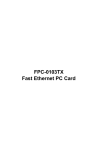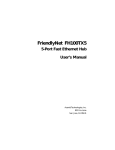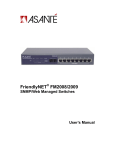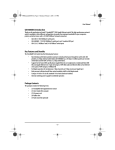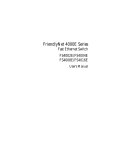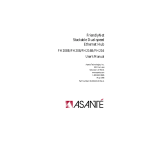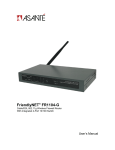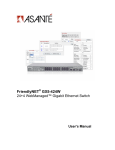Download Asante FS4004DS User`s manual
Transcript
FRCH1Book Page 1 Thursday, September 25, 1997 11:23 AM FriendlyNet Fast Ethernet Switch FS4004DS/FS4008DS User’s Manual FRCH1Book Page 2 Thursday, September 25, 1997 11:23 AM FRCH1Book Page 1 Thursday, September 25, 1997 11:23 AM FriendlyNet Fast Ethernet Switch FS4004DS/FS4008DS User’s Manual Asanté Technologies, Inc. 821 Fox Lane San Jose, CA 95131 1.800.662.9686 www.asante.com September 1997 Part Number: 06-00384-00 Rev. A FRCH1Book Page 2 Thursday, September 25, 1997 11:23 AM Copyright Notice Copyright 1997 by Asanté Technologies, Inc. All rights reserved. No part of this manual, or any associated artwork, software, product design or design concept, may be copied, reproduced or stored, in whole or in part, in any form or by any means mechanical, electronic, optical, photocopying, recording or otherwise, including translation to another language or format, without the express written consent of Asanté Technologies, Inc. Trademarks Asanté Technologies and FriendlyNet are trademarks of Asanté Technologies, Inc. Ethernet is a registered trademark of the Xerox Corporation. All brand names and products are trademarks or registered trademarks of their respective holders. FCC Information This device complies with part 15 of the FCC Rules. Operation is subject to the following two conditions: (1) this device may not cause harmful interference and (2) this device must accept any interference received, including interference that may cause undesired operation. Operation of this equipment in a residential area is likely to cause interference, in which case, the user, at his or her own risk and expense, will be required to correct the interference. Asanté Warranty Asanté Technologies, Inc. warrants that this product will be free from defects in title, materials and manufacturing workmanship. If the product is found to be defective, then, as your sole remedy and as the manufacturer’s only obligation, Asanté Technologies, Inc. will repair or replace the product. This warranty is exclusive and is limited to the FriendlyNet Fast Ethernet Switch. This warranty shall not apply to products that have been subjected to abuse, misuse, abnormal electrical or environmental conditions, or any condition other than what can be considered normal use. Warranty Disclaimers Asanté Technologies, Inc. makes no other warranties, express, implied or otherwise, regarding the FriendlyNet Fast Ethernet Switch, and specifically disclaims any warranty for merchantability or fitness for a particular purpose. The exclusion of implied warranties is not permitted in some states and the exclusions specified herein may not apply to you. This warranty provides you with specific legal rights. There may be other rights that you have which vary from state to state. Limitation of Liability The liability of Asanté Technologies, Inc. arising from this warranty and sale shall be limited to a refund of the purchase price. In no event shall Asanté Technologies, Inc. be liable for costs of procurement of substitute products or services, or for any lost profits, or for any consequential, incidental, direct or indirect damages, however caused and on any theory of liability, arising from this warranty and sale. These limitations shall apply notwithstanding any failure of essential purpose of any limited remedy. FRCH1Book Page iii Thursday, September 25, 1997 11:23 AM Table of Contents About This Manual . . . . . . . . . . . . . . . . . . . . . . . . . . . . . . . . v Chapter Contents . . . . . . . . . . . . . . . . . . . . . . . . . . . . . . . . . . . . . . . v Document Conventions . . . . . . . . . . . . . . . . . . . . . . . . . . . . . . . . . .vi Introduction . . . . . . . . . . . . . . . . . . . . . . . . . . . . . . . . . . . 1-1 FriendlyNet Fast Ethernet Switch. . . . . . . . . . . . . . . . . . . . . . . . . .1-1 Features . . . . . . . . . . . . . . . . . . . . . . . . . . . . . . . . . . . . . . . . . . . . .1-2 Performance Features . . . . . . . . . . . . . . . . . . . . . . . . . . . . . . .1-3 Fast Ethernet and Switching Technology. . . . . . . . . . . . . . . . . . . .1-3 Fast Ethernet Technology . . . . . . . . . . . . . . . . . . . . . . . . . . . .1-3 Switching Technology. . . . . . . . . . . . . . . . . . . . . . . . . . . . . . .1-4 Switch acts as a bridge between network segments . . . .1-4 Switch supports network expansion . . . . . . . . . . . . . . . .1-4 Installation . . . . . . . . . . . . . . . . . . . . . . . . . . . . . . . . . . . . . 2-1 Package Contents . . . . . . . . . . . . . . . . . . . . . . . . . . . . . . . . . . . . . .2-1 Components. . . . . . . . . . . . . . . . . . . . . . . . . . . . . . . . . . . . . . . . . .2-2 FS4004DS. . . . . . . . . . . . . . . . . . . . . . . . . . . . . . . . . . . . . . . . .2-2 FS4008DS. . . . . . . . . . . . . . . . . . . . . . . . . . . . . . . . . . . . . . . . .2-3 Cabling and Voltage Requirements . . . . . . . . . . . . . . . . . . . . . . . .2-4 Mounting Configurations . . . . . . . . . . . . . . . . . . . . . . . . . . . . . . . .2-5 Desktop Mounting. . . . . . . . . . . . . . . . . . . . . . . . . . . . . . . . . .2-5 Wall Mounting the FS4004DS . . . . . . . . . . . . . . . . . . . . . . . . .2-6 Rack Mounting the FS4008DS . . . . . . . . . . . . . . . . . . . . . . . . .2-7 Page iii FRCH1Book Page iv Thursday, September 25, 1997 11:23 AM Connecting Network Devices. . . . . . . . . . . . . . . . . . . . . . . . . . . . 2-8 Connecting a PC to the Switch . . . . . . . . . . . . . . . . . . . . . . . 2-8 Connecting a Hub to the Switch . . . . . . . . . . . . . . . . . . . . . . 2-9 Connecting a Hub without an Uplink Port to the Switch . . 2-10 Connecting the Switch to Another Switch or Network Device . . . . . . . . . . . . . . . . . . . . . . . . . . . . . . . . . . . . . . . . . 2-11 Powering on the Switch . . . . . . . . . . . . . . . . . . . . . . . . . . . . . . . 2-12 FS4004DS . . . . . . . . . . . . . . . . . . . . . . . . . . . . . . . . . . . . . . . 2-12 FS4008DS . . . . . . . . . . . . . . . . . . . . . . . . . . . . . . . . . . . . . . . 2-12 LED Indicators . . . . . . . . . . . . . . . . . . . . . . . . . . . . . . . . . . 3-1 LED Indicators on the Switch . . . . . . . . . . . . . . . . . . . . . . . . . . . . LED Indicators for Power Connections . . . . . . . . . . . . . . . . . LED Indicators for Port Connections . . . . . . . . . . . . . . . . . . . Link/Activity LED . . . . . . . . . . . . . . . . . . . . . . . . . . . . . . 100Mbps Operation LED. . . . . . . . . . . . . . . . . . . . . . . . . FDX/Col LED . . . . . . . . . . . . . . . . . . . . . . . . . . . . . . . . . . LED Indicators for Switch Connections. . . . . . . . . . . . . . . . . PC to Switch Connection . . . . . . . . . . . . . . . . . . . . . . . . Switch to Hub Connection . . . . . . . . . . . . . . . . . . . . . . . Switch to Switch or other Network Devices Connection . . . . . . . . . . . . . . . . . . . . . . . . . . . . . . . . . . . 3-1 3-2 3-3 3-3 3-3 3-4 3-5 3-5 3-5 3-6 Troubleshooting . . . . . . . . . . . . . . . . . . . . . . . . . . . . . . . . A-1 Specifications . . . . . . . . . . . . . . . . . . . . . . . . . . . . . . . . . . B-1 Technical Support . . . . . . . . . . . . . . . . . . . . . . . . . . . . . . . C-1 Page iv FRCH1Book Page v Thursday, September 25, 1997 11:23 AM About This Manual This manual discusses two models of the FriendlyNet Fast Ethernet Switch: ❏ FS4004DS — four-port 10/100Mps Fast Ethernet Switch ❏ FS4008DS — eight-port 10/100Mps Fast Ethernet Switch These models are similar in every respect except for the number of ports.Therefore, unless otherwise noted, all information provided in this manual is applicable to both. Chapter Contents This manual is divided into the following chapters and appendices: ❏ Chapter 1,“Introduction,” describes the FriendlyNet FS4004DS and FriendlyNet FS4008DS Fast Ethernet Switch and their features. ❏ Chapter 2,“Installation,” explains how to install, mount, and power on the FriendlyNet Fast Ethernet Switch. ❏ Chapter 3,“LED Indicators,” describes how to interpret the FriendlyNet Fast Ethernet Switch’s LEDs. ❏ Appendix A,“Troubleshooting,” explains how to troubleshoot problems by monitoring the FriendlyNet Fast Ethernet Switch’s LEDs. Page v FRCH1Book Page vi Thursday, September 25, 1997 11:23 AM About This Manual ❏ Appendix B,“Specifications,” describes the FriendlyNet Fast Ethernet Switch’s technical specifications. ❏ Appendix C,“Technical Support” explains how to contact Asanté Technical Support. Document Conventions This manual uses the terms “Switch” (first letter upper case) to refer to the FriendlyNet FS4004DS or FS4008DS 10/100Mbps Fast Ethernet Switch, and “switch” (first letter lower case) to refer to all other Ethernet switches. This manual uses the following conventions to convey instructions and information: ❏ Page vi Commands and key words are in boldface font. ∆ Note: Noteworthy information, which contains helpful suggestions or references to other sections in the manual, is in this format. ▲ Important! Significant information that calls attention to important features or instructions is in this format. FRCH1Book Page 1 Thursday, September 25, 1997 11:23 AM 1 Introduction This chapter introduces the FriendlyNet Fast Ethernet Switch. It also provides an overview of Fast Ethernet and switching technology. FriendlyNet Fast Ethernet Switch Thank you for purchasing the Asanté FriendlyNet FS4004DS or the FriendlyNet FS4008DS 10/100Mbps Fast Ethernet Switch. The FS4004DS and FS4008DS are unmanaged 10/100 Fast Ethernet switches designed to address increasing network bandwidth needs and accommodate future network expansion. FS4004DS FriendlyNet 4-port Dual Speed Ethernet Switch 1 2 3 4 Uplink 100Mbps or 1 2 3 4 Link/Act Power FDX /Col 10/100Mbps Ports Figure 1-1 FriendlyNet FS4004DS FS4008DS FriendlyNet 8-port Dual Speed Ethernet Switch 1 Power 2 3 4 5 6 7 8 100Mbps Uplink or 1 2 3 4 5 6 7 8 Link/Act FDX / Col Switched 10/100Mbps Ports Figure 1-2 FriendlyNet FS4008DS Each Switch is simple to install and features power, collision, full duplex, 10/100Mbps, and link/activity LEDs for easy monitoring of the Switch and its ports. For network expansion, each Switch has an uplink port that makes it easy to connect it to another Fast Ethernet switch. Page 1-1 FRCH1Book Page 2 Thursday, September 25, 1997 11:23 AM Introduction Features The FriendlyNet FS4004DS and the FS4008DS have the following features: ❏ Compact size — designed for small to large workgroups in space-limited areas; installs on desktop, mounts on wall, or installs in a standard equipment rack (depends on model) ❏ Plug-and-play installation ❏ Connects from four to eight (depends on model) 10Base-T or 100Base-TX segments per switch ❏ Contains an uplink/ MDI-II (media dependent interface) port for uplink to another switch ❏ Auto-negotiation on all ports to determine network speed ❏ Full- or half-duplex operation on all ports ❏ Allows cascading from any port to any number of switches ❏ Complies with the IEEE 802.3u Fast Ethernet standard ❏ Works with Category 5 UTP (unshielded twisted-pair) cable ❏ Contains power, collision, full duplex, 10/100Mbps, and link/activity LEDs to aid network diagnosis and simple management ❏ Ideal for deployment with multiple high-speed servers for dedicated bandwidth 10Mbps or 100Mbps workgroups ❏ Combines dynamic memory allocation with store-andforward switching Page 1-2 FRCH1Book Page 3 Thursday, September 25, 1997 11:23 AM Fast Ethernet and Switching Technology Performance Features The FriendlyNet FS4004DS and the FS4008DS have the following performance features: ❏ ❏ ❏ ❏ ❏ ❏ Store-and-forward switching scheme ensures data integrity N-Way auto-negotiation on all ports automatically senses port speed (10/100 Mbps) and duplex mode (full duplex or half duplex) Data forwarding rate of 148,800pps (packets per second) per port at 100% of wire-speed Data filtering rate of 148,800pps per port at 100% of wire-speed 8K active MAC address entry table per device (selflearning) 8MB (FS4008DS) or 4MB (FS4004DS) packet buffer per device (dynamically allocated for each port) Fast Ethernet and Switching Technology This section provides a brief overview of Fast Ethernet and Ethernet switching technology. Fast Ethernet Technology Fast Ethernet, or 100Base-T, represents a non-disruptive, smooth evolution from the current 10Base-T technology. The100Mbps Fast Ethernet technology: ❏ ❏ ❏ ❏ Extends the 10Mbps Ethernet standard to transmit and receive data at 100Mbps Maintains the CSMA/CD Ethernet protocol Allows for simple upgrades, since it is compatible with all other 10Mbps Ethernet environments Takes advantage of your company’s existing investment in hardware, software and personnel training Page 1-3 FRCH1Book Page 4 Thursday, September 25, 1997 11:23 AM Introduction Switching Technology An Ethernet switch is a device that can direct network traffic among several Ethernet and Fast Ethernet networks. A switch increases network capacity and decreases network loading by making it possible for a LAN to be divided into different segments. Switch acts as a bridge between network segments A switch acts as a high-speed selective bridge between individual segments. Traffic that needs to go from one segment to another is automatically forwarded by a switch, without interfering with any other segments. This allows the total network capacity to be multiplied, while decreasing network loading. To ensure network reliability, a switch monitors each of its ports for signal quality and automatically disconnects stations transmitting excessive noise, reconnecting them when the problem is resolved. A switch automatically truncates data packets that exceed the maximum length for IEEE 802.3u, preventing a device from blocking the network by transmitting continuous data streams or extra-long packets. Switch supports network expansion For Fast Ethernet networks, a switch is an effective way of eliminating problems of chaining hubs beyond the “two-repeater limit.” A switch can be used to split parts of the network into different collision domains, making it possible to expand your Fast Ethernet network beyond the 205 meter network diameter limit for 100BASE-TX networks. Switches supporting both traditional 10Mbps Ethernet and 100Mbps Fast Ethernet are also ideal for bridging between existing 10Mbps networks and new 100Mbps networks. Page 1-4 FRCH1Book Page 1 Thursday, September 25, 1997 11:23 AM 2 Installation This chapter explains how to install the FriendlyNet Fast Ethernet Switch. It contains the following sections: ❏ Package Contents ❏ FriendlyNet Fast Ethernet Switch components ❏ Cabling and voltage requirements ❏ Mounting configurations ❏ Connecting network devices ❏ Powering on the Switch Package Contents The FriendlyNet FS4004DS and the FS4008DS are shipped with the following items: ❏ (1) FriendlyNet 4-port FS4004DS or 8-port FS4008DS Fast Ethernet Switch ❏ (1) AC power cord ❏ (4) Self-adhesive rubber feet ❏ (1) Wall-mount kit (FS4004DS only) which includes two screws and two screw anchors ❏ (1) Rack-mount kit (FS4008DS only) which includes two rack-mounting brackets and mounting screws ❏ (1) User’s Manual (this book) Page 2-1 FRCH1Book Page 2 Thursday, September 25, 1997 11:23 AM Installation Components This section describes the front- and back-panel layouts of the FS4004DS and FS4008DS. FS4004DS The front panel of the FS4004DS consists of four 10/100 Mbps ports, one Uplink port, and LED indicators. See Figure 2-1. Uplink Port FS4004DS FriendlyNet 4-port Dual Speed Ethernet Switch 1 2 100Mbps 3 4 Uplink or 1 2 3 4 Link/Act Power FDX /Col 10/100Mbps Ports LEDs Figure 2-1 Four 10/100 Ports FriendlyNet FS4004DS front panel The back panel of the FS4004DS consists of an AC power connector. See Figure 2-2. AC Power Connector Figure 2-2 ∆ FriendlyNet FS4004DS back panel Note: The FS4004DS does not have a power switch. The FS4004DS is automatically powered on as soon as the power cord is connected to the FS4004DS and to a power outlet Page 2-2 FRCH1Book Page 3 Thursday, September 25, 1997 11:23 AM Components FS4008DS The front panel of the FS4008DS consists of eight 10/100 Mbps ports, one Uplink port, and LED indicators. See Figure 2-3. Uplink Port FS4008DS FriendlyNet 8-port Dual Speed Ethernet Switch 1 2 3 4 5 6 7 8 100Mbps Power Uplink or 1 2 3 4 5 6 7 8 Link/Act FDX / Col Switched 10/100Mbps Ports LEDs Figure 2-3 Eight 10/100 Ports FriendlyNet FS4008DS front panel The back panel of the FS4008DS consists of a power switch, an AC power connector, and a system fan. AC Power Connector System Fan Figure 2-4 Power Switch FriendlyNet FS4008DS back panel Page 2-3 FRCH1Book Page 4 Thursday, September 25, 1997 11:23 AM Installation Cabling and Voltage Requirements This section describes the cabling and voltage requirements of the Switch. Cabling Requirements 100Base-TX requires data-grade (Category 5) UTP (unshielded twistedpair) cable. ▲ Important! Some installations have Category 5 cabling but do not have wall outlets and/or wiring closet punch-down blocks that meet Category 5 requirements. 100Base-TX requires that all wiring and accessories meet EIA/TIA 568B specifications for proper operation. When wiring a 100Base-TX network, make sure that the entire cable plant meets specifications. Voltage Requirements ▲ Important! Check the AC power line voltage used in your area. The AC power adapter included with your Switch must match the power supply voltage used in your area. ❏ Page 2-4 AC input power: Equal to the AC power voltage used in your area FRCH1Book Page 5 Thursday, September 25, 1997 11:23 AM Mounting Configurations Mounting Configurations This section describes how to mount the Switch on a desktop or a wall. It also explains how to install the Switch in an equipment rack. Desktop Mounting To mount the Switch on a desktop or shelf: 1 Attach the four rubber feet (supplied) to the bottom of each corner on the Switch. See Figure 2-5 FS4008DS lyNet Friend Uplink 1 2 3 4 5 6 7 2 4 3 100Mbps Link/Act FDX 2 1 5 6 7 8 8 Power Figure 2-5 or tch rnet Swi l Speed Ethe 8-port Dua 0Mbps Ports 10/10 Switched / Col Desktop mounting Place the Switch on a flat, stable, horizontal desktop or shelf. Make sure you allow enough ventilation space between the Switch and surrounding objects. The Switch is ready for network connections. Page 2-5 FRCH1Book Page 6 Thursday, September 25, 1997 11:23 AM Installation Wall Mounting the FS4004DS The FS4004DS comes with a wall-mount kit. ▲ Important! The FS4008DS cannot be mounted on a wall. To mount the FS4004DS on a wall, consider the following when selecting a site for the FS4004DS: ❏ Select a site that is free of obstructions from other equipment or devices ❏ Place the Switch high enough to easily observe LED indicators and to allow for easy power and cable access ❏ Decide whether you want the Switch’s front panel to face either up or down To mount the FS4004DS on a wall: 1 Measure the screw holes on the bottom of the FS4004DS. 2 Drill two holes into the wall equalling the same distance as measured in step 1. ▲ Important! Do not drill the holes too deep into the wall. 3 Insert the plastic anchors (supplied) into the drilled holes and gently tap them in with a hammer. 4 Insert and turn the screws (supplied) into the plastic anchors, leaving a small portion of the screws sticking out. 5 Lift the FS4004DS and align the slots on the bottom of the FS4004DS with the screw anchors. 6 Gently slide the FS4004DS onto the screws. The FS4004DS wall mounting is complete. The FS4004DS is ready for network connections. Page 2-6 FRCH1Book Page 7 Thursday, September 25, 1997 11:23 AM Mounting Configurations Rack Mounting the FS4008DS The FS4008DS comes with a rack-mounting kit. ▲ Important! The FS4004DS cannot be installed in an equipment rack. The FS4008DS can be mounted in a standard 19-inch equipment rack. This rack can be placed in a wiring closet with other equipment. To install the FS4008DS in an equipment rack: 1 Attach the two mounting brackets (supplied) on each side of the FS4008DS. See Figure 2-6. Power 1 2 3 4 5 FriendlyN 6 7 et 8-port Dual Speed 8 100Mbps Uplink Ethernet Switch or Link/Act FDX 1 FS4008DS 2 3 4 5 6 7 / Col 8 Switched 10/100Mb ps Ports Figure 2-6 2 Attaching mounting brackets to the FS4008DS Mount the FS4008DS in the equipment rack by screwing the mounting brackets to the equipment rack. See Figure 2-7. Power 1 2 3 4 5 FriendlyNe 6 7 8-port Dual Speed 8 100Mbps Link/Act FDX Uplink t Ethernet Switch or 1 2 FS4008DS 3 4 5 / Col 6 7 8 Switched 10/100Mbp s Ports Figure 2-7 Mounting the FS4008DS in an equipment rack The FS4008DS rack mounting is complete. The FS4008DS is ready for network connections. Page 2-7 FRCH1Book Page 8 Thursday, September 25, 1997 11:23 AM Installation Connecting Network Devices Before you connect network devices to the Switch, review the following guidelines: ✔ Make sure the network cable length is less than 100 meters. ✔ Use a straight-through twisted pair cable or a cross-over cable. ✔ When connecting two switches together (cascading switches), make sure that the link between them is not longer than 100 meters. ✔ Network cable segments can be connected to, or disconnected from, the Switch while the Switch’s power is on. Connecting a PC to the Switch ❏ Use a two-pair Category 5 UTP straight-through cable with RJ-45 connectors. ❏ Connect the PC to any of the Switch’s ports (1 -4 for the FS4004DS or 1 - 8 for the FS4008DS). See Figure 2-8. FS4008DS FriendlyNet 1 Power 2 3 4 5 6 7 8-port Dual Speed Ethernet Switch 8 100Mbps Uplink or 1 2 3 4 5 Link/Act FDX / Col Switched 10/100Mbps Ports straight-through cable Figure 2-8 Page 2-8 Connecting a PC to the Switch 6 7 8 FRCH1Book Page 9 Thursday, September 25, 1997 11:23 AM Connecting Network Devices Connecting a Hub to the Switch ❏ Use a two-pair Category 5 UTP straight-through cable with RJ-45 connectors. ❏ Connect the hub’s uplink port to any of the Switch’s ports (1 – 4 for the FS4004DS or 1 – 8 for the FS4008DS). See Figure 2-9. FS4008DS FS4008DS FriendlyNet 1 2 3 4 5 6 7 8-port Dual Speed Ethernet Switch 8 Uplink 100Mbps Power or 1 2 3 4 5 6 7 8 Link/Act FDX / Col Switched 10/100Mbps Ports straight-through cable Hub FriendlyNet FH100TX5 8-port Fast Ethernet Hub Partition Partition Pwr 1 2 3 4 5 6 7 8 Col Link/Activity 1 2 3 4 5 6 7 8 Uplink OR hub’s uplink port Figure 2-9 Connecting a hub to the Switch Page 2-9 FRCH1Book Page 10 Thursday, September 25, 1997 11:23 AM Installation Connecting a Hub without an Uplink Port to the Switch If a hub is not equipped with an uplink port, connection can be made using either a straight-through cable or a cross-over cable, as outlined below. FS4008DS switch FS4008DS FriendlyNet 1 2 3 4 5 6 7 8-port Dual Speed Ethernet Switch 8 Uplink 100Mbps Power or 1 2 3 4 5 6 7 8 Link/Act FDX / Col Switched 10/100Mbps Ports cross-over cable straight-through cable FriendlyNet FH100TX5 8-port Fast Ethernet Hub Partition Partition Pwr 1 2 3 4 5 6 7 8 Col Link/Activity 1 2 3 4 5 6 7 8 Hub Figure 2-10 Connecting a hub without an uplink port to the Switch Using Straight-Through Cable ❏ Connect the Switch’s uplink port to any port on the hub. Using Cross-over Cable ❏ Connect any of the Switch’s ports (1 – 4 for the FS4004DS or 1 – 8 for the FS4008DS) to any port on the hub. Page 2-10 FRCH1Book Page 11 Thursday, September 25, 1997 11:23 AM Connecting Network Devices Connecting the Switch to Another Switch or Network Device The Switch can be connected to another switch or to other network devices (such as a router, bridge, etc.) via a two-pair Category 5 UTP straight-through or cross-over cable. See Figure 2-11. Switch A FS4008DS FriendlyNet 1 2 3 4 5 6 8-port Dual Speed Ethernet Switch 8 7 Uplink 100Mbps Power or 1 2 3 4 5 6 7 8 Link/Act FDX / Col Switched 10/100Mbps Ports cross-over cable straight-through cable Switch B FS4008DS FriendlyNet 1 2 Power 3 4 5 6 7 8-port Dual Speed Ethernet Switch 8 100Mbps Uplink or 1 2 3 4 5 6 7 8 Link/Act FDX / Col Switched 10/100Mbps Ports Figure 2-11 Connecting the Switch to another switch or network device Using Straight-Through Cable ❏ Connect the Switch’s uplink port to any of the other switch’s/device’s 10Mbps or 100Mbps ports. Using Crossover Cable ❏ Connect any port on the Switch (Switch A) to any of the 10Mbps or 100Mbps ports on the other switch (switch B). Page 2-11 FRCH1Book Page 12 Thursday, September 25, 1997 11:23 AM Installation Powering on the Switch This section describes how to power on the FS4004DS and the FS4008DS Fast Ethernet Switch. FS4004DS The FS4004DS’s may be turned on with or without LAN segment cables connected. To power on the FS4004DS: 1 Connect one end of the power cord (supplied) into the AC power connector on the FS4004DS’ back panel. 2 Connect the power cord to a local power source outlet. Note: There is no power switch on the FS4004DS. The FS4004DS is automatically powered on as soon as the power cord is connected to the Switch and to a power outlet. The FS4008DS’s power supply adjusts to the local power source automatically. . FS4008DS The FS4009DS may be turned on with or without LAN segment cables connected To power on the FS4008DS: 1 Connect one end of the power cord (supplied) into the AC power connector on the FS4008DS’ back panel. 2 Connect the power cord to a local power source outlet. 3 Turn the power switch to the “on” position. The FS4008DS’s power supply adjusts to the local power source automatically. . Page 2-12 FRCH1Book Page 1 Thursday, September 25, 1997 11:23 AM 3 LED Indicators This chapter explains how to interpret the front-panel LED indicators on the FriendlyNet Fast Ethernet Switch. The indicators are discussed in the following sections. ❏ LED indicators on the Switch ❏ LED indicators for power connections ❏ LED indicators for port connections ❏ LED indicators for Switch connections LED Indicators on the Switch The LED indicators on the Switch are used to facilitate monitoring and troubleshooting. These LEDs are: ❏ Power ❏ Link/Act (Link/Activity) ❏ 100 Mbps Operation ❏ FDX/Col (Full-duplex/Collision) Page 3-1 FRCH1Book Page 2 Thursday, September 25, 1997 11:23 AM LED Indicators The front-panel LEDs for the FS4004DS and the FS4008DS are shown in Figure 3-1 and Figure 3-2, respectively. FriendlyNet 4-port Dual Speed Ethernet Switch 1 2 3 Uplink 1 2 or 100Mbps Link/Activity Full Duplex/ 10/100M Collision 4 100Mbps Link/Act Power FDX /Col Power Figure 3-1 FS4004DS LEDs Power 1 Power 2 3 4 5 6 7 8 100Mbps Link/Act FDX Figure 3-2 / Col 100Mbps Link/Activity Full Duplex/ Collision FS4008DS LEDs LED Indicators for Power Connections After the Switch is turned on, the LED indicators should respond as follows: ❏ All LED indicators blink momentarily. This represents a reset of the system. ❏ The FDX/Col LED indicators blink from yellow to green. ❏ The power LED indicator lights and remains ON. If this indicator is not lit, check to make sure that the AC power connector is properly connected in the socket and that the power switch is ON. Page 3-2 FRCH1Book Page 3 Thursday, September 25, 1997 11:23 AM LED Indicators for Port Connections LED Indicators for Port Connections Link/Activity LED The green Link/Activity LED indicates if there is a device detected on the other end of the port and if there is traffic on the port. Table 3-1 describes the possible status indications of the Link/Activity LEDs. Table 3-1 Link/Activity LED status indicators State Status On Normal data/link pulse reception Off No twisted-pair cable connected Link pulse disabled at other end No power to the switch, twisted-pair connection faulty Non-100Base-TX device at other end Twisted-pair cable exceeds recommended length Blinking Receiving network traffic 100Mbps Operation LED The 100Mbps Operation LED indicates if a 10Mbps or a 100Mbps device is connected to the port. Table 3-2 describes the possible status indications of the 100Mbps Operation LED Table 3-2 100Mpbs LED status indicators State Status On A 100Mbps device is connected to a port or the uplink port Off A 10Mbps device is connected to a port or the uplink port Page 3-3 FRCH1Book Page 4 Thursday, September 25, 1997 11:23 AM LED Indicators FDX/Col LED The FDX/Col (full duplex/collision) LED indicates when a port is in full duplex (FDX) mode, or when two or more stations on the specific network segment attempt to transmit packets simultaneously, causing a packet collision. ∆ Note: This LED can display both green and yellow colors (see Table 3-1). ∆ Note: Collisions are normal in Fast Ethernet networks. Excessive collisions may indicate that your network is congested. Table 3-1 describes the possible status indications of the FDX/Col LEDs. Table 3-1 FDX/Collision LED status indicators State Status On (green) Port is in full duplex (FDX) mode Off Port is in half duplex (HDX) mode Blinking (yellow) Two or more stations on the network are attempting to transmit packets simultaneously to the port, causing a collision Page 3-4 FRCH1Book Page 5 Thursday, September 25, 1997 11:23 AM LED Indicators for Switch Connections LED Indicators for Switch Connections PC to Switch Connection The LED indicators for PC connection are dependent on the PC’s LAN card capabilities. Table 3-2 describes the possible status indications of the PC to Switch connections: Table 3-2 PC to Switch Connection LED Status 100 Mbps Link/Activity FDX/Collision On Connected at 100 Mbps PC connected Connected at full duplex mode Off Connected at 10 Mbps PC not connected Connected at half duplex mode Switch to Hub Connection Table 3-3 describes the possible status indications of the Switch to Hub connection: Table 3-3 Hub to Switch Connection LED Status Hub Types 100Mbps Link/Act FDX/ Collision 10BaseT Hub OFF ON OFF 100Base-T Hub ON ON OFF Page 3-5 FRCH1Book Page 6 Thursday, September 25, 1997 11:23 AM LED Indicators Switch to Switch or other Network Devices Connection Table 3-4 describes the possible status indications of the Switch to switch or other network devices connection. Table 3-4 Switch to Switch Connection LED Status FDX/ Collision Cable Types 100Mbps Link/Act Straight Cable ON 100Mbps ON Depends on the connected switch or other devices ON Depends on the connected switch or other devices OFF 10Mbps Crossover Cable ON 100Mbps OFF 10Mbps Page 3-6 FRCH1Book Page 1 Thursday, September 25, 1997 11:23 AM A Troubleshooting Table A-1 describes how to troubleshoot problems with your network and/or the Switch by monitoring the Switch’s LEDs. Table A-1 Troubleshooting Problem Action Power LED is off ✔ Make sure the power adapter is connected to the power outlet and is properly inserted into the power connector on the switch. ✔ Determine if the power outlet is functional by plugging another device into the receptacle. Collision LED is blinking constantly Collisions are normal in Fast Ethernet networks; however, excessive collisions may indicate that your network is overly congested. ✔ Make sure the workstation cables do not exceed the maximum length of 100 meters. ✔ Make sure the workstation cables meet EIA/ TIA 568B specifications for Category 5 wiring. ✔ Make sure the total network diameter does not exceed the maximum distance. ✔ Make sure there are no faulty Fast Ethernet adapters or other equipment on the network. Page A-1 FRCH1Book Page 2 Thursday, September 25, 1997 11:23 AM Troubleshooting Problem Action Link LED is off ✔ ✔ Make sure the switch is powered on. ✔ Make sure the proper cabling is used between the device and the Switch (refer to the cable guidelines specified in Chapter 2). ✔ Make sure the correct cable is properly connected to the Switch and the network device. ✔ Make sure the cable does not exceed recommended length (100 meters). ✔ Make sure the duplex mode on both ends of the link connection is configured to the same mode (half or full duplex). ✔ If your adapter card supports NWay autonegotiation, make sure the driver also supports full duplex mode. Slow performance Page A-2 Make sure the device on the other end is powered on. FRCH1Book Page 1 Thursday, September 25, 1997 11:23 AM B Specifications FS4004DS and FS4008DS Specifications Standards ❏ ❏ ❏ ❏ IEEE 802.3 10Base-T Ethernet IEEE 802.3u 100Base-TX Fast Ethernet IEEE 802.3 frame types: transparent IEEE 802.3 MAC layer frame size: 64 to 1518 bytes Protocol CSMA/CD Data Transfer Rate Ethernet: Fast Ethernet 10Mbps (half duplex): 100Mbps (half duplex) 20Mbps (full duplex): 200Mbps (full duplex) Topology Star Network Cables 10Base-T: ❏ 2-pair UTP Category 5 (100m maximum) 100Base-TX: ❏ Number of Ports 2-pair UTP Category 5 (100m maximum) FS4004DS: 4 x 10/100 Mbps ports FS4008DS: 8 x 10/100 Mbps ports Page B-1 FRCH1Book Page 2 Thursday, September 25, 1997 11:23 AM Specifications FS4004DS and FS4008DS Specifications Media Interface Exchange MDI-II RJ-45 shared with port 1x Physical and Environmental AC Inputs 100 - 240 VAC, 50/60 Hz (internal universal power supply) Power Consumption 40 watts maximum Operating Temperature 32° – 122° F (0° - 50° C) Storage Temperature -22° – 140° F (-30° – 60° C) Humidity 5% to 95% non-condensing Dimensions FS4004DS: 232 x 142 x 43 mm (1U) FS4008DS: 324 x 231 x 43 mm (1U) Weight FS4004DS: 1.2Kg FS4008DS: 2.5Kg EMI FCC Class A, CE Mark, VCCI Class I Safety UL (UL 1950), CSA (CSA950) Page B-2 FRCH1Book Page 3 Thursday, September 25, 1997 11:23 AM Performance Specifications FS4004DS and FS4008DS Specifications Performance Transmission Method Store-and-forward RAM Buffer FS4004DS: 4MB per device FS4008DS: 8MB per device Filtering Address Table 8K entries per device Packet Filtering/ Forwarding Rate 148,800 pps per port (for 100 Mbps) Page B-3 FRCH1Book Page 4 Thursday, September 25, 1997 11:23 AM FRCH1Book Page 1 Thursday, September 25, 1997 11:23 AM C Technical Support Contacting Technical Support To contact Asanté Technical Support: Telephone (800) 622-7464 Fax (408) 432-6018 Fax-Back (800) 741-8607 Internet Mail [email protected] World Wide Web Site http://www.asante.com Bulletin Board Service (BBS) (408) 432-1416 ARA BBS (guest log-in) (408) 894-0765 AppleLink Mail/BBS ASANTE FTP Archive ftp.asante.com Technical Support Hours 6:00 a.m. to 5:00 p.m. Pacific Standard Time USA, Monday - Friday. Page C-1 FRCH1Book Page 2 Thursday, September 25, 1997 11:23 AM FRCH1Book Page i Thursday, September 25, 1997 11:23 AM Index Numerics E 100Base-TX, cables supported B-1 100Mbps LED 3-3 10Base-T, cables supported B-1 10Mbps LED 3-3 EMI B-2 equipment rack installation 2-7 expansion, network 1-4 A fast ethernet features of 1-3 overview 1-3 switch. See FS4008DS or FS4004DS FDX/collision LED 3-4 features 1-2 performance 1-3 filtering address table B-3 rate, data 1-3 /forwarding rate, packet B-3 forwarding rate, data 1-3 FriendlyNet switch. See FS4004DS or FS4008DS front panel LEDs, overview 3-1 FS4004DS back panel 2-2 components 2-2 features 1-2 front panel 2-2 LEDs diagram 3-2 overview 3-1 mounting options 2-5 overview 1-1 performance features 1-3 power, connecting 2-12 specifications B-1 wall mounting 2-6 FS4008DS back panel 2-3 components 2-3 equipment rack installation 2-7 features 1-2 front panel 2-3 LEDs diagram 3-2 overview 3-1 about this manual v AC inputs B-2 power connector 2-3 activity LED 3-3 address entry table, MAC 1-3 table, filtering B-3 assistance. See technical support auto-negotiation 1-3 B bridge vs. switch 1-4 buffer packet 1-3 RAM B-3 C cabling requirements 2-4 category 5 cable 2-4 chapter contents v collisions LED 3-4 troubleshooting A-1 CSMA/CD B-1 D data filtering rate 1-3 forwarding rate 1-3 transfer rate B-1 desktop mounting 2-5 devices, connecting 2-8 – 2-11 dimensions B-2 document conventions vi duplex mode, troubleshooting A-2 F Index-i FRCH1Book Page ii Thursday, September 25, 1997 11:23 AM FS4008DS (continued) mounting options 2-5 overview 1-1 performance features 1-3 power, connecting 2-12 specifications B-1 full duplex LED 3-4 troubleshooting A-2 H help. See technical support or troubleshooting hub connecting to switch 2-9, 2-10 to switch, LED 3-5 humidity B-2 I IEEE 802.3 B-1 installation 2-1 cabling requirements 2-4 devices, connecting hub to switch 2-9, 2-10 PC to switch 2-8 switch to switch 2-11 network devices, connecting 2-8 package contents 2-1 powering on 2-12 voltage requirements 2-4 installation desktop mounting 2-5 equipment rack installation 2-7 mounting options 2-5 wall mounting 2-6 L LEDs collision description 3-4 troubleshooting A-1 duplex description 3-4 troubleshooting A-2 Index-ii LEDs (continued) link/activity description 3-3 troubleshooting A-2 overview 3-1 PC to switch connection 3-5 power troubleshooting A-1 connections 3-2 switch to hub connection 3-5 to switch connection 3-6 link LED 3-3 troubleshooting A-2 M MAC address entry table 1-3 manual about v chapter contents v document conventions vi media interface exchange B-2 mounting options 2-5 desktop 2-5 equipment rack 2-7 wall 2-6 N network cables supported B-1 devices connecting 2-8 guidelines 2-8 expansion 1-4 segments, defined 1-4 O operating temperature B-2 overview v, vi fast ethernet 1-3 installation 2-1 manual v switch 1-1 switching technology 1-3 FRCH1Book Page iii Thursday, September 25, 1997 11:23 AM P package contents 2-1 packet buffer 1-3 filtering/forwarding rate B-3 PC (personal computer) connecting to switch 2-8 to switch, LED 3-5 performance features 1-3 troubleshooting A-2 personal computer (PC), connecting to switch 2-8 port 100Mbps LED 3-3 10Mbps LED 3-3 activity LEDs 3-3 connection LEDs 3-4 link LEDs 3-3 power connecting 2-12 connector 2-3 consumption B-2 LEDs 3-2 troubleshooting A-1 problems, determining A-1 product overview 1-1 protocol, supported B-1 R rack, equipment, installation 2-7 RAM buffer B-3 requirements cabling 2-4 voltage 2-4 switch connecting to another switch 2-11 defined 1-4 to switch, LED 3-6 vs. bridge 1-4 See also FS4008DS or FS4004DS switching overview 1-3 scheme 1-3 technology, overview 1-4 system fan 2-3 T table filtering address B-3 MAC address entry 1-3 technical specifications B-1 support C-1 temperature operating B-2 storage B-2 topology supported B-1 transmission method B-3 troubleshooting A-1 U UTP (unshielded twisted-pair) cable 2-4 V voltage requirements 2-4 W wall mounting 2-6 weight B-2 S safety specifications B-2 segments, network, defined 1-4 specifications B-1 standards, supported B-1 storage temperature B-2 store-and-forward switching scheme 1-3 support, technical C-1 Index-iii FRCH1Book Page iv Thursday, September 25, 1997 11:23 AM FRCH1Book Page 1 Thursday, September 25, 1997 11:23 AM FRCH1Book Page 2 Thursday, September 25, 1997 11:23 AM ASANTÉ TECHNOLOGIES, INC., 821 FOX LANE, SAN JOSE, CA 95131 PHONE: 408.435.8388, 800.662.9686 • FAX: 408.432.7511 • e-mail address: [email protected] • World Wide Web site: http://www.asante.com ©1997 Asanté Technologies Inc., Asanté is a trademark of Asanté Technologies, Inc. All brand names and products are trademarks or registered trademarks of their respective holders. September 1997 Part Number 06-00384-00 Rev. A












































